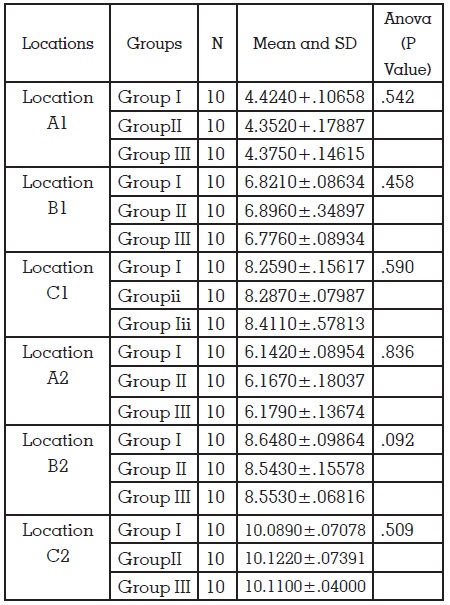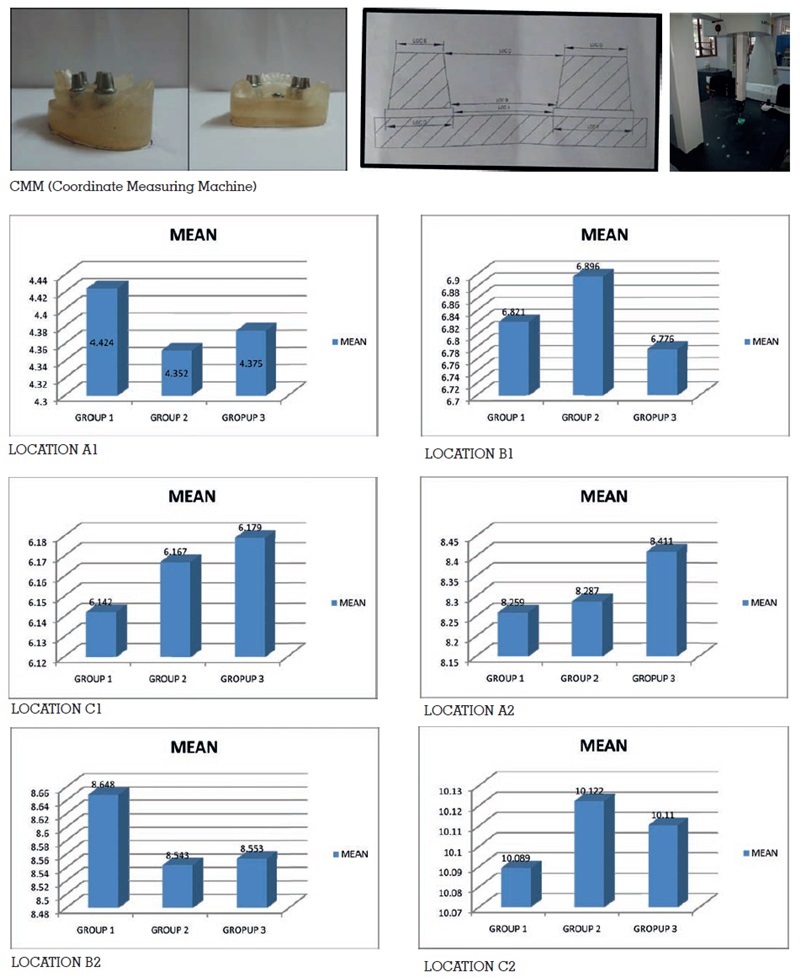

Aim: The aim of this study is to determine whether the difference in mixing technique will affect the accuracy of cast poured out of an alginate impression material.
Materials and methods: Three different mixing techniques were used – mechanical mixing using alginate mixer, hand mixing (figure of eight motion), hand mixing (circular motion).
Metallic perforated rim-lock trays was used to make the impression with alginate impression material. The master model made with steel abutments at 44 and 47 & 34 and 37 region. Ten impression was made on master cast with metal impression trays. The cast was poured with type 3 dental stone. Then the distance between the reference points were measured with CMM (Coordinate Measuring Machine) and compared with the master model and analysis done by ANOVA
Results: There is no statistically significant difference (p value is not less than or equal to 0.05) was found between the cast obtained from impressions made by different mixing techniques.
Anatomical models are used for many diagnostic and treatment purposes in the dental practice. A dimensionally accurate impression is important for fabricating a precise anatomical model. The dimensional accuracy of the cast used to fabricate the cast are crucial for diagnostic and treatment planning purposes. In addition, the fabricated casts are valuable for the purposes of evaluating prosthetic space, diagnostic wax patterns for treatment planning and fabrication of resin based prostheses. The most commonly used impression material is alginate, irreversible hydrocolloid material. Irreversible hydrocolloid impression material was first introduced to the dental community in the 1940’s1. The main advantages of alginates are the ease of use, cost-effectiveness, their hydrophilic characteristics, and the good patient acceptability2. Although alginate is easy to manipulate, the correct handling (water/powder ratio, spatulation) affects dimensional accuracy of the material. Therefore, it is imperative to follow the manufacturer’s prescriptions on mixing3.
Recently, several dental manufacturers have introduced electronic rotary devices to facilitate mixing of irreversible hydrocolloid impression materials. These instruments easily produce a fine paste low in air bubbles compared with paste mixed by hand. Therefore, it is estimated that paste obtained by this method possesses superior rheological properties by reducing the number and volume of porosities in the mixed alginate4. With regard to impression making techniques, very few contemporary studies exist.
The objective for these in-vitro studies was to evaluate dimensional stability of casts produced from different mixing techniques.
The null hypotheses tested was: there is no difference in dimensional stability of casts made from impressions by different alginate mixing techniques.
Materials Used:
A lower arch master model was made of self-curing Orthodontic Resin (Dentsply) with resin teeth from canine to canine and four machined stainless steel dies. The four stainless steel simulating prepared abutment teeth were embedded in region 37 and 34 & 44 and 47 region. The stainless steel dies were designed to simulate circular full crown preparations with shoulders. The molar die preparations had 6° total occlusal convergence (TOC), were 7.0 mm high, and had a cervical outer diameter of 9.0 mm and a shoulder width of 1.0 mm. The premolar dies had the same TOC, height and shoulder width, but an outer diameter of 7 mm. The root portion of the stainless steel dies were 15 mm in length and had a design that well locked them inside the resin to prevent rotation and vertical displacement. Approximately 1 mm of the dies root portion was exposed on all four dies. Diamond bur was used to make marks on the occlusal surfaces and the shoulders of the dies. Reference points were marked on the cast, at 3 locations, on either side of the cast, giving a total of 6 points. The two adjacent intra abutment points were joined to obtain 3 locations. The model is then fixed in a wooden frame. Alginate Impression material was mixed by three different mixing techniques using Algimix Alginate mixer, hand mixing(figure of eight), hand mixing(circular motion) according to manufacturer’s instructions. Ten impressions each were made. Then cast was poured with type 3 dental stone immediately. Then the distance between the reference points were measured with CMM (Coordinate Measuring Machine) and analysis done by ANOVA.

One of the goals for this study was to demonstrate if there is a significant difference between manualmixing and electronically-mixed impression materials.

However, due to the number of variables being studied, there was no statistical evidence to arrive at a conclusion that one mixing technique produced better impression materials for improved accuracy of cast than the other. The vacuum-mixing technique does produce a smooth, uniformly mixed, bubble-free impression5. But the statistics was not able to distinguish which mixing technique provides casts with better accuracy.
According to ThidaPhyo and MyatNyan Alginate impressions prepared with automatic mixing method have better dimensional accuracy than those mixed by hand6.
Koski showed that alginate mixed with the device produced fewer surface defects and had better detail reproduction with cast gypsum than handmixing (Koski, 1997). Inoue et al. (2002) investigated the setting characteristics and rheological properties of alginate mixed by three methods: a hand-mixing technique,a semi-automatic mixing instrument, and an automixed instrument. They found almost no porosities using the auto-mixed instrument and concluded that in clinical use, homogenous mix produced by auto-mixed is preferred over hand mixing (Inoue etal., 2002)4.
Alginate materials prepared with a method that produces less porosity may have improved properties such as recovery from deformation, strain in compression, compressive strength, surface detail reproduction, and dimensional stability (Hamilton et al., 2010)5.
However, it is noted that the working time of automatically mixed paste was significantly decreased. It may be because when the material is mixed at high speed, the temperature of the paste increases slightly due to friction between the material and mixing container. Similarly Inoue et al. (2002) showed that pastes mixed automatically had a markedly shorter working and setting time compared with hand-mixing4.
Within the limitation of the present study, it can be concluded that the difference in mixing technique will not affect the accuracy of cast poured out of an alginate impression material.